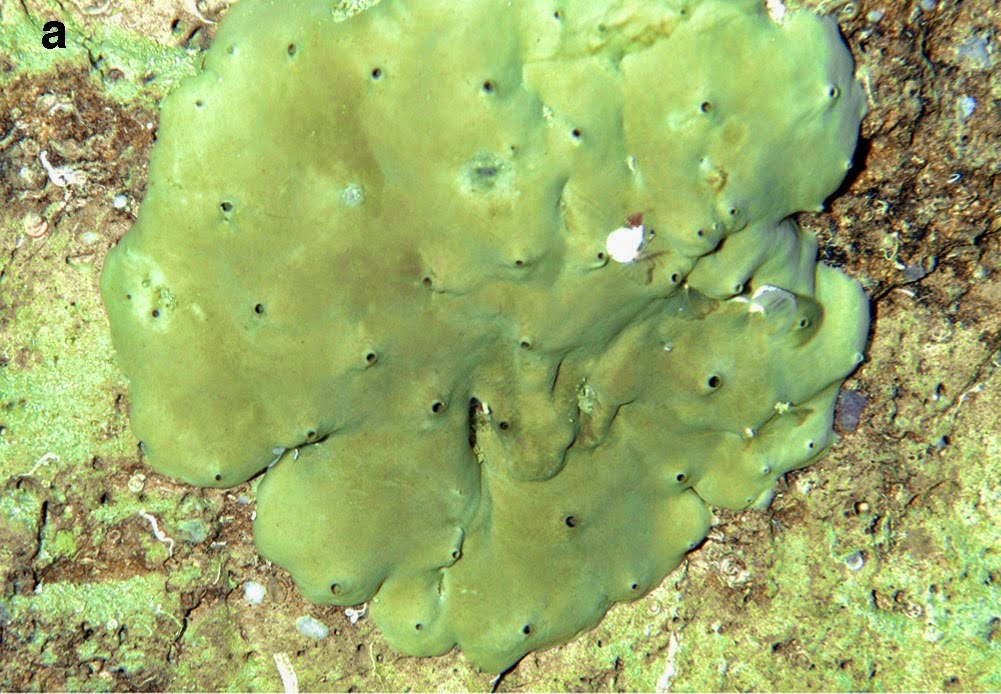Reworked Late Ordovician Sponges have been collected from Miocene to
Pleistocene across a wide area of northern Europe for over two centuries. These
are associated with the course of the Baltic River System, which drained much
of northern Europe for much of this time period. There are four main
assemblages of such fossils recognised. The German-Dutch Sponge Assemblages are
collected from the border area between Germany and the Netherlands, and were
deposited on the Baltic River Delta in the Early Pleistocene. The material here
is found in brown silicified limestones and chert (these are common materials
in fossil assemblages rich in Sponges, as the silica spicules of the Sponge
dissolve, then precipitate out with chemical changes in the buried sediments,
replacing other materials), and is referred to as the Brown Sponge Assemblage.
The deposits around Lausitz, to the southeast of Berlin, were deposited in the
Middle Miocene, and comprise largely bluish-grey or black silicified material,
known as the Lavendel Blaue Hornsteine. The Island of Sylt in northwestern
Germany produces reworked material laid down in the Pliocene; this is dominated
by material from the Lavendel Blaue Hornsteine, with a small amount of Brown
Sponge Assemblage material. The Brown Sponge Assemblage is also found on the
Swedish island of Gotland, in the Baltic, where a wide variety of Sponges have
been recognised.
In a paper published in the journal Scripta Geologica in March 2014, Freek Rhebergen
of Emmen in the Netherlands describes a new species of Anthaspidellid Demosponge
from reworked Ordovician material from Gotland, the Dutch-German border region
and the Island of Sylt.
The new species is named Brevaspidella dispersa,
where ‘Brevaspidella’ means
‘little-short-shield’, in reference to the shape of the Sponge, short and
cylindrical with a shield-like top, and ‘dispersa’
means ‘disperse’ a reference to the scattered osculi (exhalent openings) on its
surface (Sponges are filter feeders that pump water in through tiny
canal-openings all over their surface, and out through one or more larger
openings known as ‘osculi’). The species is described from specimens from the
Museum of Gotland, the Swedish Museum of Natural History, the
Archiv für Geschiebekunde in the Geologisch-Paläontologisches Institut und Museum
of the University of Hamburg and several private collections.
Specimen of Brevaspidella dispersa from
unknown locality on Gotland, Sweden. Flat to slightly concave upper surface
with cluster of osculi and some converging lateral canals. Rhebergen (2014).
Brevaspidella dispersa is a small Sponge, typically less than 5 cm across, with the height
and diameter about the same. The upper surface is slightly concave with
scattered osculi, the base flat or slightly concave with a thickened dermal
layer with concentric wrinkles.
Brevaspidella dispersa. (A, B) Specimen from beach near Västlanda, Gotland, Sweden. (A)
View on upperside with dispersed osculi and radial surface canals. (B) Lateral
view with concentrically wrinkled dermallayer in the lower part. (D, E) Specimen
from unknown locality on Gotland, Sweden. (D) The top shows morethan 50 osculi,
scattered over the flat surface. (E) Side view. Dermal layer poorly developed
and restrictedto the base. Rhebergen (2014).
See also…
The shallow water reefs around Bonaire and Klein Curaçao in the
Caribbean Netherlands are well studied and are considered a biodiversity
hotspot, but the...
Sponges
(Porifera) are generally considered to be the oldest extant animal group, with
a fossil record that extends considerably into the Precambrian; phylogenomic
analysis suggests they are the sister group to all other animals, which also
suggests an early origin for the group.
Chalinid Dermosponges are among the hardest Sponges to classify
taxonomically due to their simple anatomies and variable morphologies.
They are encrusting Sponges with skeletons made up of...
Follow Sciency Thoughts on Facebook.





